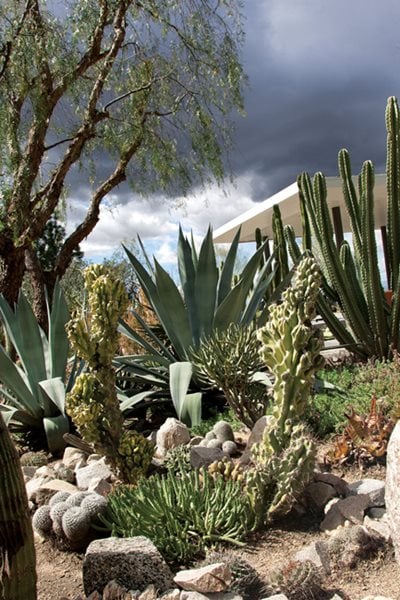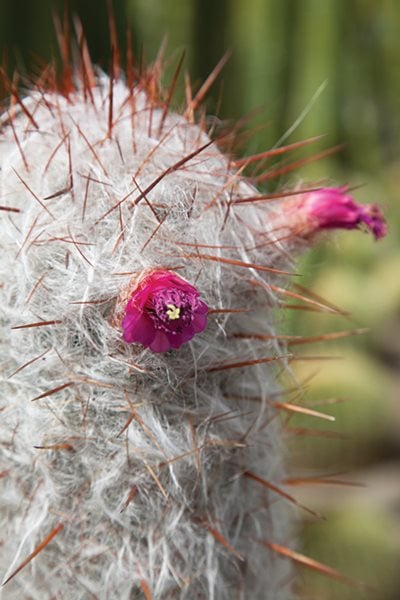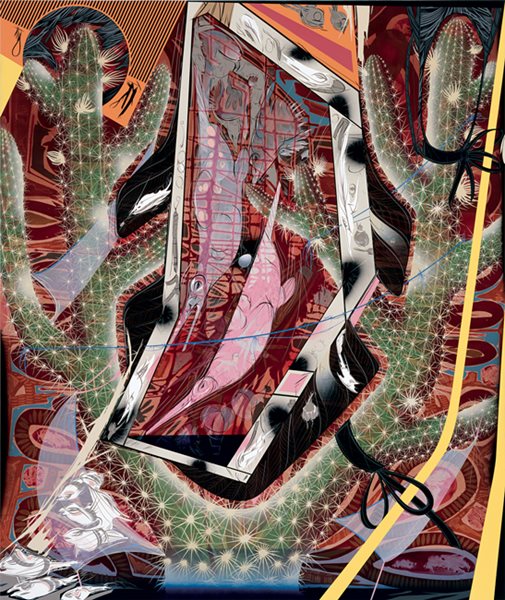A Waterwise Cactus Garden, Photo Gallery
Enjoy this slideshow of the home and gardens of artists Roy Dowell and Lari Pittman. At their home in the foothills of Los Angeles, cacti and succulents flourish. We've included tips on how to care for these favored botanicals
To read more about this garden and its owners, read A Waterwise Cactus Garden.

Tall Aloe bainesii and Echinocactus grusonii flank a house designed by Los Angeles architect Michael Maltzan.

Among the garden’s many succulents and cacti are Cereus peruvianus ‘Monstrosus’, Agave americana, and C. peruvianus.

A 1952 Richard Neutra house is filled with light thanks to a profusion of windows that offer sweeping views.

Clipped rosemary hedges and olive trees line Reforma, a path leading to a small teahouse. The artists named the sections of their garden after different parts of the world, this one being Provence, France.

Caring for Succulents and Cacti
Even though they can tolerate heat and don’t need much water, succulents and cacti are actually quite fragile. Shelly and Ken Jennings of Worldwide Exotics supplied many of Parque Oaxaca’s plants, and they share the following advice on how to keep them alive.
- In winter, a frozen paddle or limb is like gangrene and should be immediately pruned.
- All plants will benefit from layering.

Caring for Succulents and Cacti
- A too-rich soil mix is trouble: blend half of the plant’s original soil with local dirt, compost, and perlite.
- Good drainage is essential.
- If using a fertilizer, look for cactus-specific varieties.
- For propagation from cuttings, cut in late summer or early fall, wait until the section is well-hardened off, water well at planting, and then let it dry out.

Caring for Succulents and Cacti
- Over-watering is the most common problem with succulents, especially during the winter dormant period when watering should be cut to almost nothing.
- Do not let water collect in the center rosettes of aloe.
- Avoid using tap water that has too much alkaline.

When putting in their plants, Roy Dowell and Lari Pittman eschewed traditional landscaping rules in favor of an artistic vision ruled by mathematical symmetry and repetition.

Oreocereus celsianus ‘Maximus’ (old man cactus) is a frost-tolerant cactus that grows up to 10 feet tall and 8 feet wide in full sun. Magenta flowers appear in summer.

Cereus peruvianus (hedge cactus or Peruvian tree cactus) is a columnar cactus that can reach up to 20 feet tall. Grown in full sun, its color varies from gray to greenish blue. It branches and bears fragrant flowers, followed by edible pink fruit.

Echinocactus grusonii (golden barrel cactus), common in the Southwest, grows to 3 feet tall and blooms from late March to early April.

Opuntia santa-rita (Santa Rita prickly pear) has purplish pads and bright-yellow flowers in spring. It can handle some shade.

Roy Dowell and Lari Pittman have taught art (Dowell at the Otis College of Art and Design, and Pittman at UCLA) and exhibited their work around the world for the past three decades. Dowell creates conceptual pieces primarily with a collage of paint and elements of mass media. Pittman combines abstract forms with iconography and text in his densely layered paintings. Both artists have a longtime love of plants, which occasionally show up in their work.
Left: Untitled (#885), 2003, by Roy Dowell.
Courtesy of Margo Leavin Gallery, Los Angeles.

Courtyard, 2006, by Lari Pittman.
Courtesy Regen Projects, Los Angeles.

Untitled #7, 2007, by Lari Pittman




